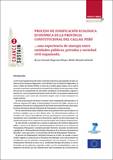|
By Luz Consuelo Muguruza Minaya, Walter Menacho Gallardo & Isa Baud
Policy Brief No.7 - November 2012 Peru is an interesting case to examine in terms of synergy between public and private sector and organized civil society, because of its long-term commitment to ‘concertacion’ processes, in which stakeholders play an integral part1. Therefore, this policy brief focuses on a major example of such processes involving the use of spatial knowledge management within a context of regional cooperation between province and local governments and CSOs, in the most important industrial area adjacent to Lima, the Constitutional Province of Callao.
The Constitutional Province of Callao is the smallest of twenty-five Regional Governments, located west of Lima, the country’s capital, along the Pacific coast. It is part of the metropolitan area (Lima Callao), and holds the most important national and regional economic activities as well as Peru’s first port and main international airport – chosen as the best airport in South America for the fourth consecutive year. Different administrative powers coexist within Callao’s area: the Regional Government of Callao and the Provincial Municipality of Callao coexist with the national government’s administration of the port (National Port Authority) and the airport (Ministry of Communications and Transport).
These characteristics help define Callao as a complex organizational space where public organizations and civil society have been developing participatory processes in the last few years (concertacion). The outcomes of these participatory processes are considered useful for guiding the design and management of other planning instruments according to the responsibilities of each administrative level. The aim of this policy brief is to share the experience of the Regional Government of Callao in the design and management of the “Ecological-economic Micro-zoning of the Constitutional Province of Callao” as a preparatory phase for formulating its land-use plan. The Regional Government carried out this micro-zoning process through its Spatial Planning Office, part of the Regional Office of Budget, Planning and Spatial Planning. It shows how issues of participation, spatial information and knowledge management, the use of geographic information systems as basis for integrated knowledge management and multi-level governance come together in such processes.
|
Recent Chance2Sustain Publications |
|
|
|
|
|

